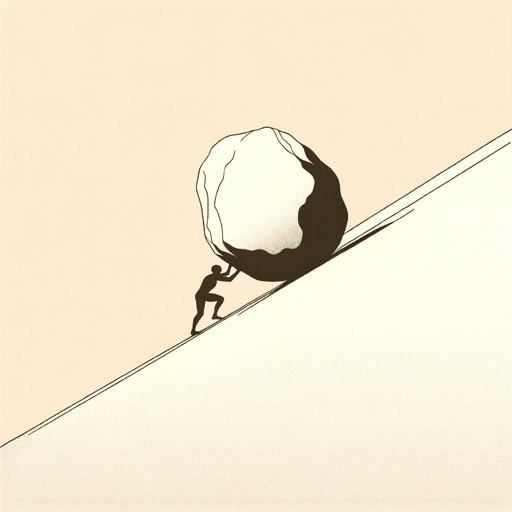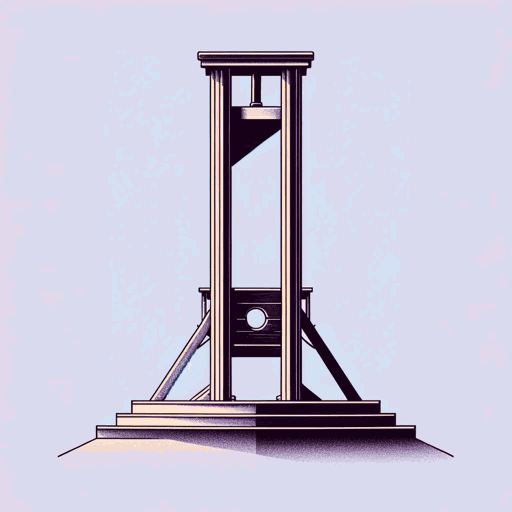

A Summary and Analysis of the Myth of Sisyphus
By Dr Oliver Tearle (Loughborough University)
The poster-boy of existentialism, Sisyphus has become associated with laborious and pointless tasks, because he was condemned to roll a boulder up a hill, only for the boulder to roll back down to the bottom just as he was about to complete the task. He was thus doomed to repeat this action forever.
However, there’s a lot more to the story of Sisyphus than this snapshot, so let’s take a closer look at the Sisyphus myth, who he was, and why he was so important to ancient Greek civilisation.
Summary of the Sisyphus myth
Although he’s best-known now for rolling a stone up a hill, Sisyphus did lots before he was doomed to repeat that (literal) uphill struggle. He was the mythical founder of the city-state of Corinth (called Ephyra at the time) and was viewed as the successor to Medea – she of the doomed relationship with Jason, of Argonauts fame.
He was also credited with founding the Isthmian games, which were held both the year before and the year after the Olympic Games (the second and fourth years of an Olympiad), from around 582 BC (nearly two centuries after the first Olympic games were held).
Sisyphus is credited with siring, among others, Glaucus, Bellerophon, and even – in one version – wily Odysseus himself. The story goes that Autolycus had stolen Sisyphus’ flock, but Sisyphus, viewed by many as the most cunning of all men, had taken the precaution of branding his name onto his animals, so he could prove the stolen flock was his.
Autolycus’ daughter Anticleia was due to marry Laertes the next day after this thwarted act of farmyard theft took place, and Sisyphus, to get his revenge, slipped into Anticleia’s bed the night before her wedding and seduced her. She conceived Odysseus as a result.
But because Autolycus was impressed by Sisyphus’ cleverness, he happily gave up his daughter to Sisyphus, because he wanted to have a wily and quick-thinking grandson. Odysseus certainly grew up to be just that, as Homer’s Odyssey attests. Laertes, in this version of the Odysseus’ story, wasn’t Odysseus’ biological father, then.
But how did Sisyphus end up being condemned to roll a boulder up a hill, for all eternity? That, too, depends on which version of the myth you read.
For instance, according to one account, Sisyphus ended up rolling that rock uphill because he snitched on Zeus during one of the god’s various acts of abduction involving young and beautiful women. When Zeus made off with Aegina, Sisyphus saw him. Aegina’s father, Asopus, found out that Sisyphus had witnessed it and he asked Sisyphus to tell him who had taken his daughter.
Sisyphus, ever the wily man, made him a deal: he’d tell Asopus who had made off with his daughter if Asopus made a spring gush onto the citadel of Corinth. Asopus agreed to this, and Sisyphus dropped Zeus right in it.
Zeus, whose short temper was as legendary as his penchant for running off with maidens, wasn’t too happy about Sisyphus dobbing him in like this, so he struck Sisyphus down with a thunderbolt. Transported to the Underworld, Sisyphus was condemned to roll a boulder up a hill, for all eternity.
Homer, however, tells the story quite differently. Here, Sisyphus’ ‘crime’ was refusing to die when the gods decreed it. So, Zeus sent Thanatos, the spirit of Death, to carry the stubborn Sisyphus off to the Underworld. But Zeus had underestimated how wily Sisyphus was, and Sisyphus was waiting for Thanatos when he arrived, chained up this deathly agent, and in doing so, suspended death across all of the world. With Thanatos in captivity, nobody – including Sisyphus himself – could die.
But you cannot cheat death forever, and Sisyphus was forced, by Zeus, to unchain Thanatos so that the daily business of death could resume.
Unfortunately for Sisyphus, his name was first on the list.
But once again, Sisyphus tricked his way out of it. He hatched a plan with his wife, telling her that when they carried him off to the Underworld, she shouldn’t observe the funeral rites usually accorded a dead person. When Sisyphus arrived before Hades in the Underworld, he complained that his wife had refused to honour him when he died, and Hades agreed to let him go back and chastise his rude widow. The trick worked, and Sisyphus somehow got away with living for many more years.
When he did eventually die, the gods made sure he couldn’t trick his way out of the Underworld again, by setting him the endless task with which he is now so closely associated: rolling that massive rock forever up a hill, only to find – when he reached the top of the hill – that the rock rolled all the way back down to the bottom and he had to start all over again.
Analysis of the Sisyphus myth
Not all Greek myths have a ‘moral’ as such, but it’s clear, when we look at a fuller summary of the story (or stories) of Sisyphus, that his punishment – rolling that rock endlessly up a hill – was contrived by the gods in response to Sisyphus’ legendary craftiness and cunning. You really can be too clever for your own good: Sisyphus was.
The story of Sisyphus is so well-known in modern times thanks to Albert Camus, whose essay ‘ The Myth of Sisyphus ’ (1942) is an important text about the absurdity of modern life (although it’s often described as being ‘Existentialist’, Camus’ essay is actually closer to Absurdism).
For Camus, Sisyphus is the poster-boy for Absurdism, because he values life over death and wishes to enjoy his existence as much as possible, but is instead thwarted in his aims by being condemned to carry out a repetitive and pointless task. Such is the life of modern man: condemned to perform the same futile daily rituals every day, working without fulfilment, with no point or purpose to much of what he does.
However, for Camus – and again, this part is generally misunderstood by people who haven’t read Camus’ essay but only heard about its ‘argument’ at second hand – there is something positive in Sisyphus’ condition, or rather his approach to his rather gloomy fate. When Sisyphus sees the stone rolling back down the hill and has to march back down after it, knowing he will have to begin the same process all over again, Camus suggests that Sisyphus would come to realise the absurd truth of his plight, and treat it with appropriate scorn.
In a sense, he is ‘free’: not from having to perform the task, but from performing it unquestioningly or in the vain hope that it will end. He has liberated his own mind by confronting the absurdity of his situation, and can view it with the appropriate contempt and good humour. As the old line has it, ‘you have to laugh …’
Of course, the Greek gods were capricious, and weren’t always justified when meting out their punishments to mortals, but Sisyphus’ determination to cheat death is obviously doomed to failure, in the long run.
Indeed, the ancient Greeks knew, as every civilisation worthy of the name has known, that death is an inevitable and even desirable part of life: for people to live forever would be unbearable, a hell on earth, with no room being made for the next generation. In all the various versions of the myth of Sisyphus, he is not merely cunning (a quality we can applaud), but self-interested .
He sleeps with Laertes’ bride-to-be as revenge for Autolycus’ attempted theft of his flock, and, one suspects, because he fancied the girl himself. He dropped Zeus in it with Asopus, not because he believed it the morally right thing to do, but because there was something in it for him. And he tried to cheat death because he didn’t want to face his own end.
We might admire Sisyphus for his quick-thinking skills and his guile, but what makes him a compelling Greek ‘hero’ – if we can use that word of him – is his selfish streak that makes him flawed, and, therefore, more human to us.
About Greek mythology
The Greek myths are over two thousand years old – and perhaps, in their earliest forms, much older – and yet many stories from Greek mythology, and phrases derived from those stories, are part of our everyday speech. So we describe somebody’s weakness as their Achilles heel , or we talk about the dangers of opening up Pandora’s box . We describe a challenging undertaking as a Herculean task , and speak of somebody who enjoys great success as having the Midas touch .
Discover more from Interesting Literature
Subscribe now to keep reading and get access to the full archive.
Type your email…
Continue reading

The Myth of Sisyphus
Albert camus, everything you need for every book you read..
In The Myth of Sisyphus , Albert Camus aims to draw out his definition of absurdism and, later in the book, consider what strategies are available to people in living with the absurd. The absurd is often mischaracterized as the simple idea that life is meaningless. In fact, Camus defines the absurd as the confrontation between man’s desire for logic, meaning and order, and the world’s inability to satisfy this desire. Camus believes that confronting the absurd takes precedence over all other philosophical problems, because it is intimately linked with the act of suicide. People commit suicide when life is meaningless, he says, and sometimes to defend the meaning that they do perceive (for instance, someone dying for a political cause). If life is meaningless, which is a proposition Camus certainly agrees with, is it logical to commit suicide—dutiful, even? Camus outlines how people turn to religion and hold on to the hope of a better life that never comes in order to suppress the absurd. Camus wants to know if it’s possible to live in full awareness of the fact that life is meaningless.
Camus examines the work of philosophers like Soren Kierkegaard , Lev Chestov , Karl Jaspers and Edmund Husserl . All of these, says Camus, went some way to outlining the absurdity of life. But each of them has a fatal flaw—they were too afraid to commit to the absurdity of life, and instead restored meaning to the world through a leap of faith (usually to God). They try to conjure meaning out of meaninglessness, which Camus sees as distinctly irrational. Camus argues for three main characteristics of the absurd life: revolt, freedom and passion. The absurd life must resist any temptation for answers or explanations in life; act and think with total freedom; and pursue life with passion.
In “The Absurd Man,” Camus tries to move towards a more practical approach to the absurd, providing examples of figures that he feels have accommodating the absurd into their lives. For Camus, it is not about finding a solution to the absurd, but living a life that maintains full awareness of life’s meaninglessness. As an illustrative example, he looks first at Don Juan , a notorious seducer. He praises Don Juan for living a life of quantity, rather than quality—since no experience is inherently more valuable than any other, the absurd man should strive to experience as much as he can. In Don Juan’s case, this means sex with as many different women as possible. Camus’ other examples of absurd lives are actors —who live in the present and try out many different lives—and conquerors , whose political and violent struggles add urgency and vividness to life.
Camus then turns his attentions to the relationship between the absurd and creation. The creative life, says Camus, is an especially absurd one. Artists expend great energy on their creation, though their creation is ultimately meaningless. The creator can only experience and describe, not explain and solve; Camus is disdainful of those works that have a “smug” motive of proving a particular “truth.” Within this framework, Camus examines the writings of the Russian novelist, Fyodor Dostoevksy . In particular, he looks at a character from The Possessed , Kirilov , who commits a kind of “logical suicide.” In order for life to have meaning, Kirilov thinks, God must exist—but Kirilov intuitively feels that there is no God and decides to take control by killing himself. His last words are “all is well,” which for Camus are precisely the words that living with the absurd require. Though Camus praises Dostoevsky for showing the absurd in action—which is a special capability of novels as opposed to philosophy—he criticizes Dostoevsky for turning back to God later in his personal life.
Camus concludes his essay by discussing the myth of Sisyphus mentioned in the title. Sisyphus, a Greek King, was condemned by the gods. His eventual fate was to push a rock up a mountain, only for it to fall back down, necessitating the process to start over again and again for all eternity. There are different stories about why Sisyphus incurred the wrath of the gods but, in essence, he disrespected them. One of the stories is that he put Death in chains, angering the god Pluto . Just before he died, Sisyphus wanted to test his wife’s love by ordering that she “cast his unburied body into the middle of the public square.” Annoyed that she actually did so, instead of burying him properly, he received permission from Pluto to return to earth in order to chastise her. Upon his return from the underworld, Sisyphus fell in love with the earth again—particularly its natural beauty—and refused to leave. Mercury was sent to retrieve Sisyphus, and when Sisyphus got back to the underworld his rock and the eternal, futile labor it represents were waiting for him. In this fate, Camus sees the struggle of man longing for meaning in a meaningless world. Sisyphus, says Camus, is the ultimate “absurd hero,” because he is fully aware of the futility of his actions. The moment when Sisyphus walks back to the foot of the mountain is the one that most interests Camus, representing Sisyphus’ “hour of consciousness” and total understanding of his fate. Camus pictures Sisyphus saying that “all is well,” like Kirilov did earlier. It is necessary, says Camus, to “imagine Sisyphus happy.”

The Myth of Sisyphus

47 pages • 1 hour read
A modern alternative to SparkNotes and CliffsNotes, SuperSummary offers high-quality Study Guides with detailed chapter summaries and analysis of major themes, characters, and more.
Chapter Summaries & Analyses
Preface-Part 1
Key Figures
Index of Terms
Important Quotes
Essay Topics

Summary and Study Guide
One of the monuments of 20th-century philosophy, The Myth of Sisyphus, by Nobel Prize-winning author Albert Camus , delves deeply into the emptiness of life and how to cope with it. Published in France in 1942, during the darkest days of World War II, the book resonated strongly with French readers and soon had a worldwide following. The 2018 edition of the 1955 English translation by Justin O’Brien forms the basis for this study guide.
The book’s premise is that humans yearn deeply for something they can never have: the certainty that life is worthwhile and meaningful. The huge gap between that craving and life’s actual sterility is an absurd condition that can’t be pushed aside but must be faced squarely. The tragic Greek figure Sisyphus—a rebel whom the gods punish by forcing him to push a boulder up a mountain only to watch it fall back down, over and over forever—symbolizes the absurd human condition.
Get access to this full Study Guide and much more!
- 7,300+ In-Depth Study Guides
- 4,950+ Quick-Read Plot Summaries
- Downloadable PDFs
Though he deserves acclaim as a representative of existentialism , a philosophy that grapples with life’s meaninglessness, Camus rejected that term and instead called himself an absurdist. He criticized existentialists for peering into the abyss of life’s emptiness and backing away in fear, believing it better to stare at absurdity unblinkingly and defiantly.
The SuperSummary difference
- 8x more resources than SparkNotes and CliffsNotes combined
- Study Guides you won ' t find anywhere else
- 100+ new titles every month
The Myth of Sisyphus contains five parts, including three extended essays on absurdity, a short piece on Sisyphus as a tragic hero of the meaningless, and an appendix that critiques Franz Kafka’s Existential novels.
Part 1, “An Absurd Reasoning,” posits that there is only one truly important philosophical problem: whether life is worth living. If life is too absurd to matter, one question remains—whether to commit suicide . Some people, despairing life’s futility, kill themselves; others explore the deserts of meaninglessness, trying fully to understand absurdity. This yearning to comprehend life fully, and thereby transcend death, can never be fulfilled; ironically, that is absurdity.
For most thinkers, the pain becomes too great, and they cast off their insights and retreat to the safety of arbitrary beliefs that posit eternal truths. Existential philosophers, whose job is to understand absurdity, are especially prone to this, either by leaping into the arms of God or into arbitrary certainties, or by worshipping absurdity. In these ways, they commit philosophical suicide. It’s better to face absurdity squarely, neither cooperating with it nor pretending it doesn’t exist.
Part 2, “The Absurd Man,” presents three examples of personalities—the Don Juan , the actor , and the conqueror—who learn how to navigate life’s absurdities. The Don Juan loves fully but briefly; he collects as many experiences as possible, knowing his actions violate morality, but preferring his life to one that oppresses both himself and his partner.
Similarly, the actor takes on many roles, concentrating those lives down to their intense highlights and focusing on their tragic, absurd fates. The conqueror or adventurer seeks action, aware of its futility but reveling in its power and thereby acquiring a certain regal dignity.
Artists daily confront the ambiguities of creative work in the face of life’s absurdity. In Part 3, “Absurd Creation,” the greatest fiction writers don’t try to teach their theories of life but simply illustrate them, using characters whose choices bring to life those ideas. If the writer stands firm and protects painful insights without escaping to the refuge of comforting falsehoods, ambiguities balloon, but so do creative possibilities.
Fyodor Dostoevsky’s protagonists confront meaningless unfairness and make decisions in the light of absurdity. For example, his character Kirilov, a successful engineer, decides to kill himself as an example to others, hoping they’ll awaken to the frustrations of society and rebel against them. Ultimately, though, Dostoevsky fails to stand up to life’s emptiness and seeks the comfort of faith in an eternal afterlife.
Part 4, “The Myth of Sisyphus,” describes the archetypal absurd man, Sisyphus, who rebels against the gods and is punished eternally, forced to push a boulder up a mountain, watch it fall back down, and push it up again, over and over for all eternity. Despite his suffering, Sisyphus takes a dark joy in his fate: Daily, he walks back down his hillside of failure with full, defiant awareness, and thus strips the gods of their power over him.
The Appendix, “Hope and the Absurd in the Work of Franz Kafka ,” is a critique of Kafka’s novels, especially The Trial and The Castle , in which the protagonists struggle futilely against unfair fates. Kafka’s great strength is his description of ordinary people trapped in impossible situations who meet their destinies with quiet acceptance and without hope of rescue. Sometimes, though, even Kafka tries to find a shred of meaning in his characters’ stories.
A thorough review of how to confront life’s absurd emptiness, The Myth of Sisyphus pulls no punches yet never sinks into despair. It serves as a guidebook to the deserts of meaninglessness through which, sooner or later, every thoughtful person must travel.

Don't Miss Out!
Access Study Guide Now
Ready to dive in?
Get unlimited access to SuperSummary for only $ 0.70 /week
Related Titles
By Albert Camus

A Happy Death
Albert Camus

The Rebel: An Essay on Man in Revolt

The Stranger
Featured Collections
Essays & speeches.
View Collection
French Literature
Mortality & death, national suicide prevention month, philosophy, logic, & ethics, religion & spirituality, truth & lies.

IMAGES
VIDEO
COMMENTS
Full Work Summary. The central concern of The Myth of Sisyphus is what Camus calls "the absurd." Camus claims that there is a fundamental conflict between what we want from the universe (whether it be meaning, order, or reasons) and what we find in the universe (formless chaos). We will never find in life itself the meaning that we want to find.
Summary of the Sisyphus myth Although he’s best-known now for rolling a stone up a hill, Sisyphus did lots before he was doomed to repeat that (literal) uphill struggle. He was the mythical founder of the city-state of Corinth (called Ephyra at the time) and was viewed as the successor to Medea – she of the doomed relationship with Jason ...
The Myth of Sisyphus, philosophical essay by Albert Camus, published in French in 1942 as Le Mythe de Sisyphe. Published in the same year as Camus’s novel L’Étranger ( The Stranger ), The Myth of Sisyphus contains a sympathetic analysis of contemporary nihilism and touches on the nature of the absurd. Together the two works established his ...
The Myth of Sisyphus Summary. 1. Absurdity and Suicide. In The Myth of Sisyphus, Albert Camus aims to draw out his definition of absurdism and, later in the book, consider what strategies are available to people in living with the absurd. The absurd is often mischaracterized as the simple idea that life is meaningless.
The Myth of Sisyphus (French: Le mythe de Sisyphe) is a 1942 philosophical essay by Albert Camus. Influenced by philosophers such as Søren Kierkegaard, Arthur Schopenhauer, and Friedrich Nietzsche, Camus introduces his philosophy of the absurd. The absurd lies in the juxtaposition between the fundamental human need to attribute meaning to life ...
In the classical myth of Sisyphus’s punishment, Camus finds the absurd hero. Sisyphus is condemned to an eternity of futile and hopeless work. He rolls a huge stone up a mountain, a struggle ...
The Myth of Sisyphus contains five parts, including three extended essays on absurdity, a short piece on Sisyphus as a tragic hero of the meaningless, and an appendix that critiques Franz Kafka’s Existential novels. Part 1, “An Absurd Reasoning,” posits that there is only one truly important philosophical problem: whether life is worth ...
The ancient gods of myth found a uniquely horrific punishment for Sisyphus: pushing an enormous and heavy rock to the top of a mountain only to have it fall back to its starting point thanks to the forces of gravity upon that weight. The punishment was considered severe: futile labor forever. The ancient poet Homer presented Sisyphus as a ...